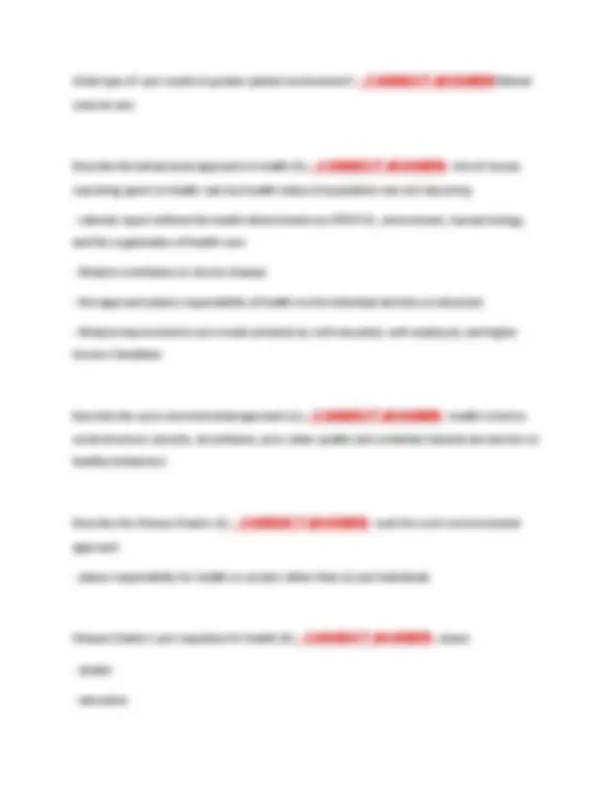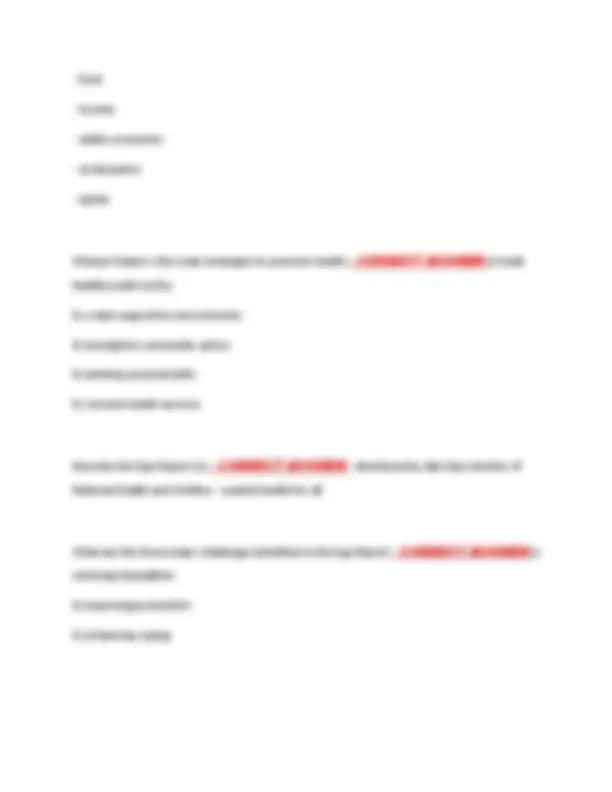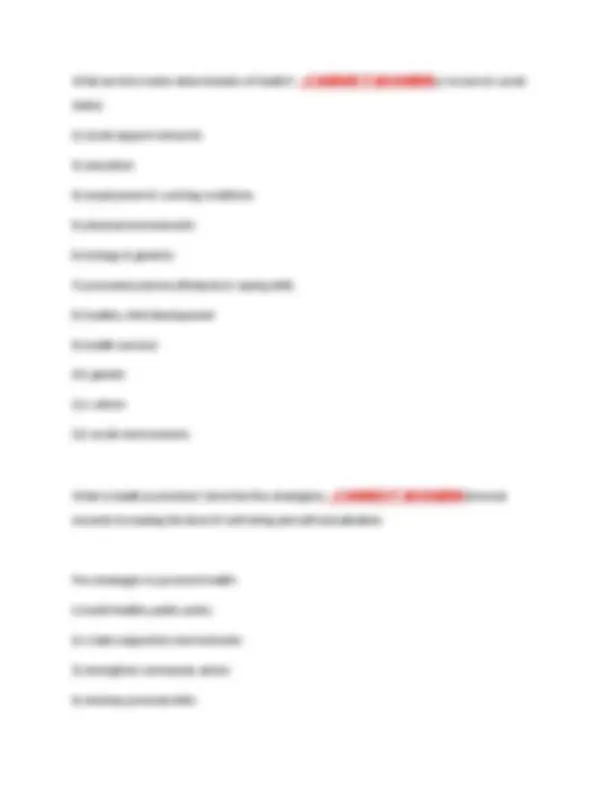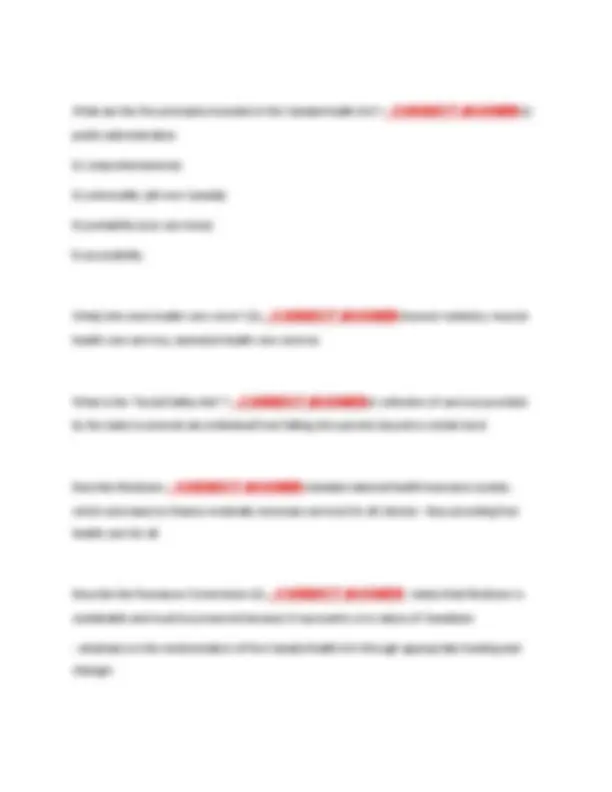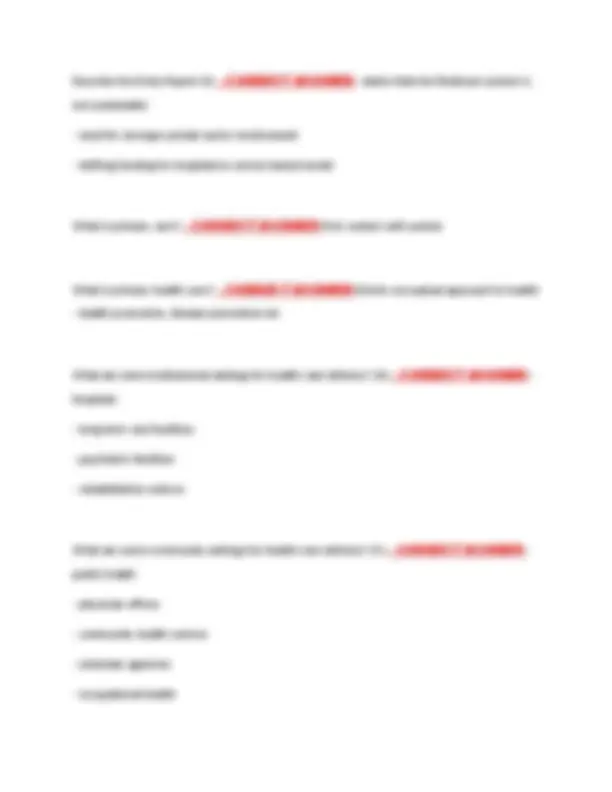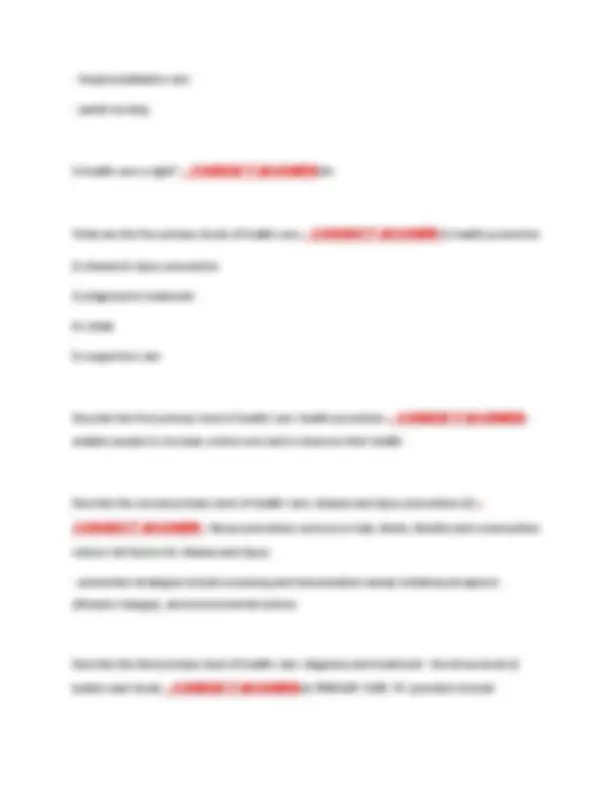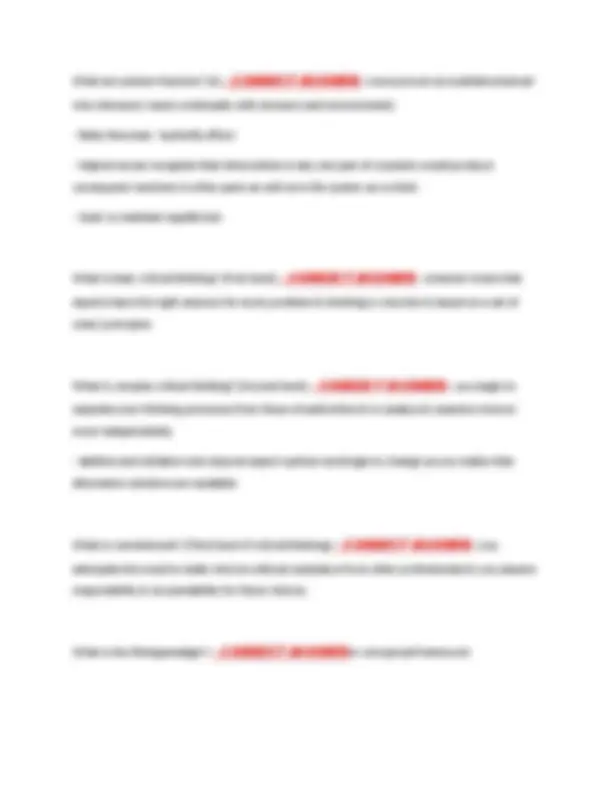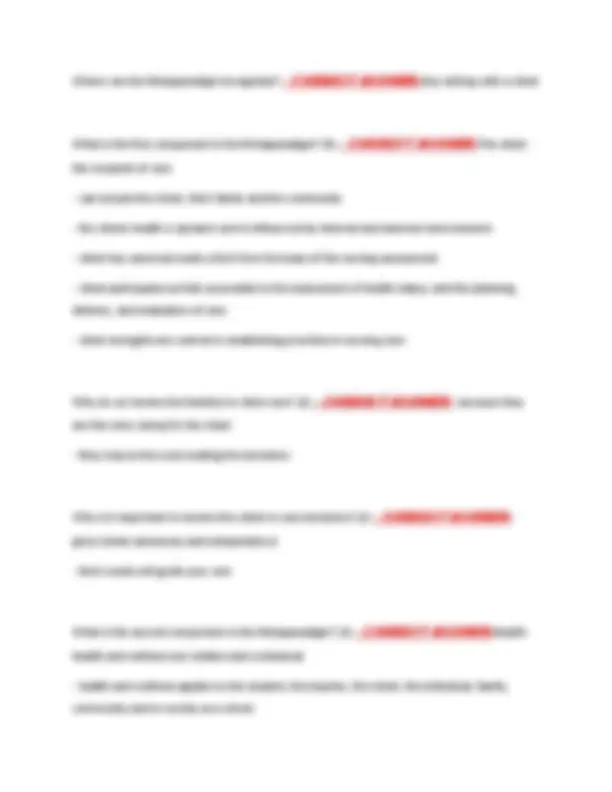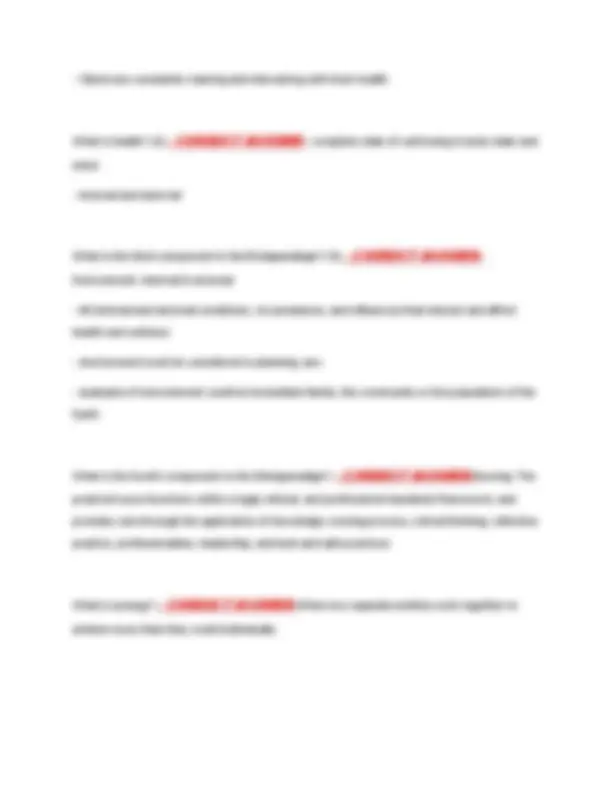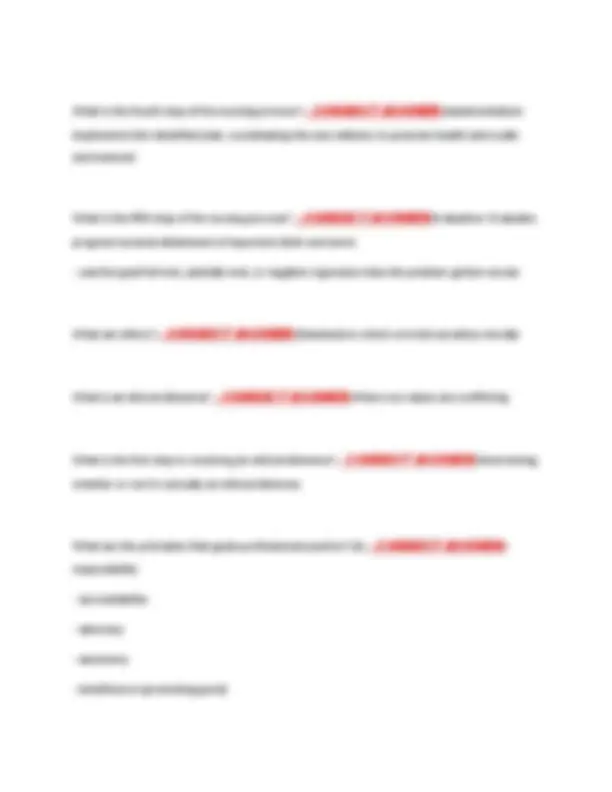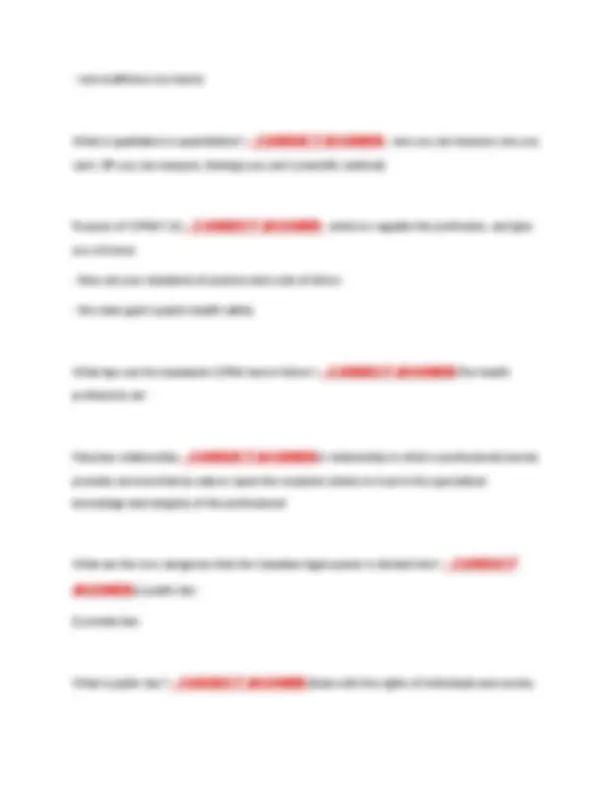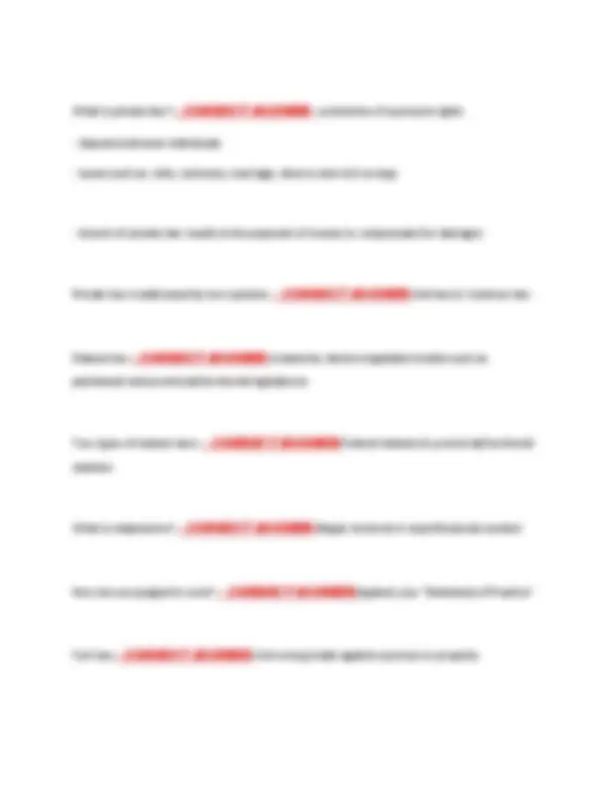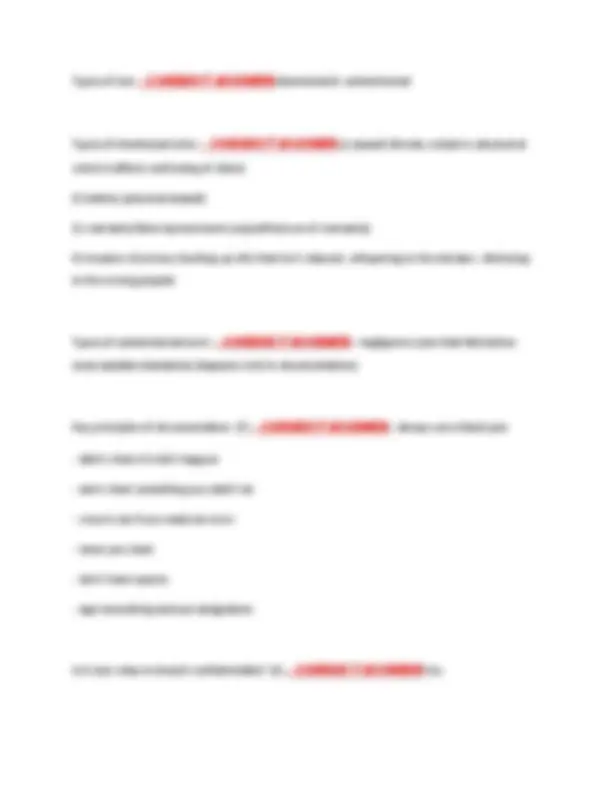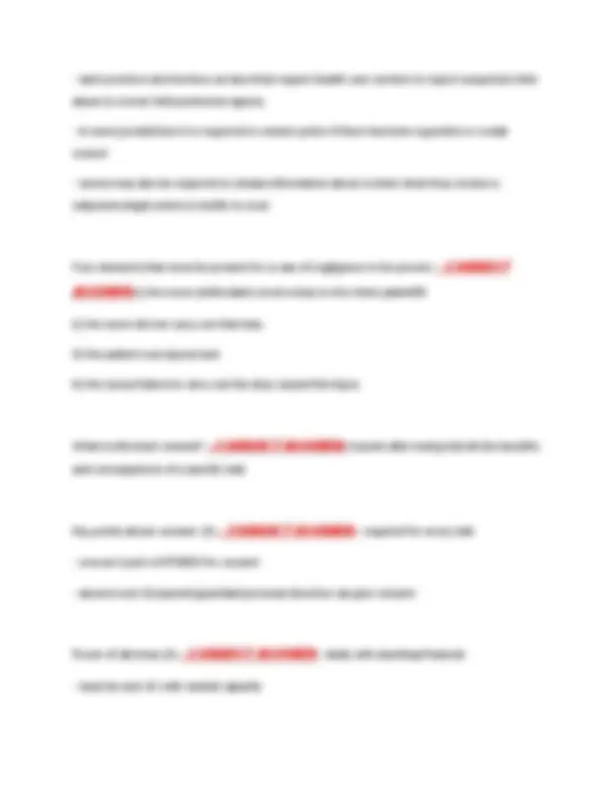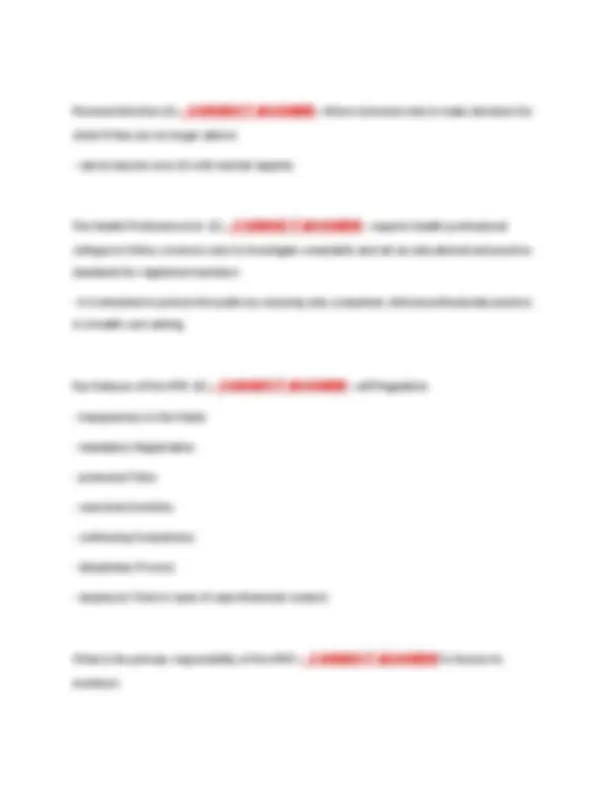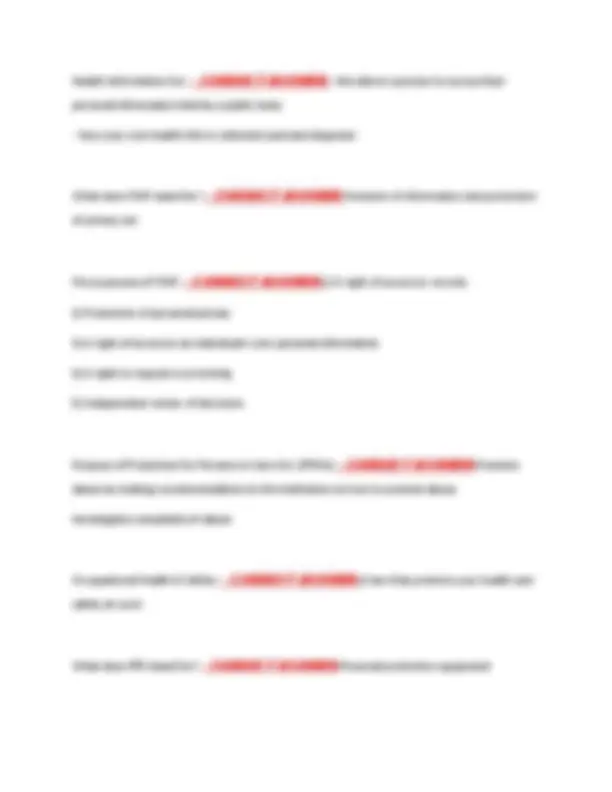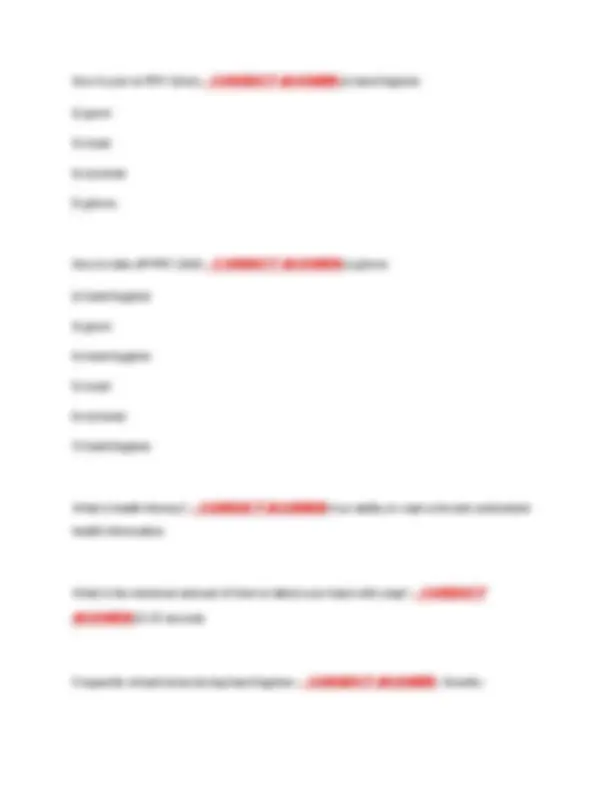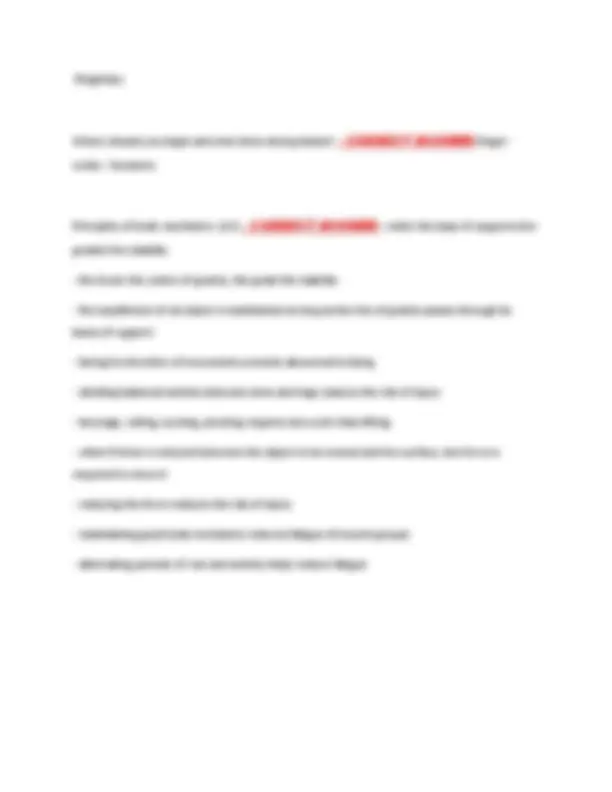Download NFDN 1001 FINAL EXAM GUIDE LATEST 2025 QUESTIONS and ANSWERS GRADED A+ and more Exams Nursing in PDF only on Docsity!
NFDN 1001 FINAL EXAM GUIDE LATEST 2025
QUESTIONS and ANSWERS GRADED A+
3: primary, secondary, tertiary
Describe the primary level of disease prevention - CORRECT ANSWER-Includes activities
that protect against a disease BEFORE signs & symptoms occur. Ex) immunizations and reducing/avoiding risk factors of certain diseases like smoking
Describe the secondary level of disease prevention - CORRECT ANSWER-Promotes early
detection of disease once pathogenesis has already occurred - prompt treatment can be initiated to halt the disease & limit any disability Ex) BP screening to detect hypertension, blood-glucose screening to detect diabetes
Describe the tertiary level of disease prevention - CORRECT ANSWER-Activities are
initiated in the convalescence stage of disease & are directed toward MINIMIZING residual disability & helping people to live productively with limitations Ex) cardiac rehabilitation after a heart attack
What are the three historical approaches to health in Canada? - CORRECT ANSWER--
medical approach
- behavioural approach
- socio-environmental approach
Describe the medical approach to health (6) - CORRECT ANSWER-- western thinking
- focuses on treatment of disease
- must have adequate health-care system
- prevalent after WWII with influx of economic growth
- national health insurance was created
- less emphasis on health promotion & disease prevention
The physicians role in the medical model - CORRECT ANSWER-The physician was seen as
the expert and patients were expected to comply with his/her advice. The physician assumes an authoritarian position in relation to the patient.
- food
- income
- stable ecosystem
- social justice
- equity
Ottawa Charter's five main strategies to promote health - CORRECT ANSWER-1) build
healthy public policy
- create supportive environments
- strengthen community action
- develop personal skills
- reorient health services
Describe the Epp Report (1) - CORRECT ANSWER-- developed by Jake Epp minister of
National Health and Welfare - wanted health for all
What are the three major challenges identified in the Epp Report - CORRECT ANSWER-1)
reducing inequalities
- improving prevention
- enhancing coping
What are the twelve determinants of health? - CORRECT ANSWER-1) income & social
status
- social support networks
- education
- employment & working conditions
- physical environments
- biology & genetics
- personal practices (lifestyle) & coping skills
- healthy child development
- health services
- gender
- culture
- social environments
What is health promotion? (And the five strategies) - CORRECT ANSWER-Directed
towards increasing the level of well-being and self-actualization Five strategies to promote health:
- build healthy public policy
- create supportive environments
- strengthen community action
- develop personal skills
Describe the third strategy to promote health: strengthen community actions (3) -
CORRECT ANSWER-- communities having control & ownership over their own
endeavours & destinies is key
- needs to enhance self-help & social support, and develop flexible system for strengthening public participation in health matters
- this requires full access to information, and voluntary bodies & within the institutions themselves
Describe the fourth strategy to promote health: reorient health services (3) - CORRECT
ANSWER-- health services need to embrace an expanded mandate which is sensitive and
respects cultural needs
- it should support the needs of individuals and communities for a healthier life
- requires attention to public research as well as changes in professional education and training
Describe the fifth strategy to promote health: develop personal skills (3) - CORRECT
ANSWER-- health promotion supports personal and social development through providing
information, education for health and enhancing life skills
- this increases options available to people (more control over their own health)
- allows people to make conductive choices involving their health
Describe the Canada Health Act (2) - CORRECT ANSWER-- to protect, promote and
restore physical & mental well being
- reasonable access without financial or other barriers
What are the five principles included in the Canada Health Act? - CORRECT ANSWER-1)
public administration
- comprehensiveness
- universality (all over Canada)
- portability (you can move)
- accessibility
What/who does health care cover? (3) - CORRECT ANSWER-Insured residents, insured
health care services, extended health care services
What is the "Social Safety Net"? - CORRECT ANSWER-A collection of services provided
by the state to prevent any individual from falling into poverty beyond a certain level
Describe Medicare - CORRECT ANSWER-Canadas national health insurance system,
which uses taxes to finance medically necessary services for all citizens - thus providing free health care for all
Describe the Romanow Commission (2) - CORRECT ANSWER-- states that Medicare is
sustainable and must be preserved because it represents core values of Canadians
- emphasis on the modernization of the Canada Health Act through appropriate funding and changes
- hospice/palliative care
- parish nursing
Is health-care a right? - CORRECT ANSWER-No
What are the five primary levels of health-care - CORRECT ANSWER-1) health promotion
- disease & injury prevention
- diagnosis & treatment
- rehab
- supportive care
Describe the first primary level of health-care: health promotion - CORRECT ANSWER--
enables people to increase control over and to improve their health
Describe the second primary level of health-care: disease and injury prevention (2) -
CORRECT ANSWER-- illness prevention services to help clients, families and communities
reduce risk factors for disease and injury
- prevention strategies include screening and immunization sexual, behavioural aspects (lifestyle changes), and environmental actions Describe the third primary level of health-care: diagnosis and treatment - the three levels (
bullets each level) - CORRECT ANSWER-A) PRIMARY CARE: PC providers include
physicians and NPS in practice settings such as physicians offices, nurse managed clinics & schools
- focus is on early detection, routine care, and education to prevent reoccurrences B) SECONDARY CARE: usually occurs in hospitals or home settings & involves specialized medical service by a specialist or a hospital refereed from a PC practitioner
- considers definitive diagnosis or clients requiring further diagnostic review C) TERTIARY CARE: specialized technical care is diagnosing and treating complicated or unusual health problems
- occurs in regional teaching, university or specialized hospitals that have sophisticated equipment for complex procedures
Describe the fourth primary level of health-care: rehab - CORRECT ANSWER-Restoration
of a person facing life-altering health situations through education, advocacy, collaboration and research
Describe the fifth primary level of health-care: supportive care - CORRECT ANSWER-
Consisted of health personal & social services provided over a prolonged period of time to people who are disabled or cannot function independently or who have a terminal disease
Who is Florence Nightingale? - CORRECT ANSWER-Founder of modern nursing
Key points about Florence Nightingale (4) - CORRECT ANSWER-- first nurse statistician
- dramatically decreased mortality and morbidity rates
What are system theories? (4) - CORRECT ANSWER-- views person as multidimensional
who interacts/ reacts continually with stressors and environments
- Betty Newman - butterfly effect
- helped nurses recognize that intervention in any one part of a system would produce consequent reactions in other parts as well as in the system as a whole
- Goal: to maintain equilibrium
What is basic critical thinking? (First level) - CORRECT ANSWER-- a learner trusts that
experts have the right answers for every problem & thinking is concrete & based on a set of rules/ principles
What is complex critical thinking? (Second level) - CORRECT ANSWER-- you begin to
separate your thinking processes from those of authorities & to analyze & examine choices more independently.
- abilities and initiative look beyond expert opinion and begin to change as you realize that alternative solutions are available
What is commitment? (Third level of critical thinking) - CORRECT ANSWER-- you
anticipate the need to make choices without assistance from other professionals & you assume responsibility & accountability for these choices.
What is the Metaparadigm? - CORRECT ANSWER-A conceptual framework
Where can the Metaparadigm be applied? - CORRECT ANSWER-Any setting with a client
What is the first component in the Metaparadigm? (5) - CORRECT ANSWER-The client:
the recipient of care
- can include the client, their family and the community
- the clients health is dynamic and is influenced by internal and external environments
- client has universal needs which form the basis of the nursing assessment.
- client participates as fully as possible in the assessment of health status, and the planning, delivery, and evaluation of care.
- client strengths are central to establishing priorities in nursing care.
Why do we involve the families in client care? (2) - CORRECT ANSWER-- because they
are the ones caring for the client
- they may be the ones making the decisions
Why is it important to involve the client in care decisions? (2) - CORRECT ANSWER--
gives clients autonomy and independence
- their needs will guide your care
What is the second component in the Metaparadigm? (3) - CORRECT ANSWER-Health:
health and wellness are relative and contextual.
- health and wellness applies to the student, the teacher, the client, the individual, family, community and to society as a whole.
What is culture competence? - CORRECT ANSWER-Being able to appraise and
understand clients culture, beliefs, values and practices
What does it mean to provide presence? - CORRECT ANSWER-Person to person
encounter that conveys closeness and a sense of caring
What are the phases of the helping relationship? - CORRECT ANSWER-1) pre-interaction
phase (before you meet client, looking at chart, talking to their other caregivers for info etc.)
- orientation phase (nurse and client are getting to know each other)
- working phase (nurse and client work together to solve a problem or meet a goal)
- termination phase (goal is met, nurse relinquishes responsibility)
What are the five key elements of professional communication? - CORRECT ANSWER-1)
courtesy
- use of names
- trustworthiness
- autonomy & responsibility
- assertiveness
What is the nursing process? (2) - CORRECT ANSWER-- method of organizing and
prioritizing care
- the whole goal is to reach a goal that improves the clients wellness
What is the first step of the nursing process? - CORRECT ANSWER-Assessment:
collectives subjective (interview) & objective information relating to clients current situation
- qualitative vs quantitative measurements
- making patterns and cues to figure out what the issue is
What is the second step of the nursing process? - CORRECT ANSWER-Nursing Diagnosis:
analyze & validate the assessment data to participate in selecting established nursing diagnosis, and issues in the client situation
Why is there such thing as a diagnosis? - CORRECT ANSWER-To improve health and
wellness as well as to help the nurse prioritize care
What are the three types of diagnosis? - CORRECT ANSWER-1) actual (NANDA label,
related to, as evidence by)
- potential (client is at risk if you don't intervene)
- wellness - not important for exam
What is the third step of the nursing process? - CORRECT ANSWER-Planning: Develops a
plan that selects strategies and alternatives to attain expected outcomes
What are the components of the SMART criteria? - CORRECT ANSWER-
What is qualitative vs quantitative? - CORRECT ANSWER-- one you can measure one you
can't. BP you can measure, feelings you can't (scientific method)
Purpose of CLPNA? (3) - CORRECT ANSWER-- exists to regulate the profession, and give
you a license
- they set your standards of practice and code of ethics
- the main goal is public health safety
What lays out the standards CLPNA has to follow? - CORRECT ANSWER-The health
professions act
Fiduciary relationship - CORRECT ANSWER-A relationship in which a professional (nurse)
provides services that by nature cause the recipient (client) to trust in the specialized knowledge and integrity of the professional
What are the two categories that the Canadian legal system is divided into? - CORRECT
ANSWER-1) public law
- private law
What is public law? - CORRECT ANSWER-Deals with the rights of individuals and society
What is private law? - CORRECT ANSWER-- protection of a persons rights
- disputes between individuals
- issues such as: wills, contracts, marriage, divorce and civil wrongs
- breech of private law results in the payment of money to compensate for damages
Private law is addressed by two systems: - CORRECT ANSWER-Civil law & Common law
Statute law - CORRECT ANSWER-Created by elective legislative bodies such as
parliament and provincial/territorial legislatures
Two types of statute laws: - CORRECT ANSWER-Federal statutes & provincial/territorial
statutes
What is malpractice? - CORRECT ANSWER-Illegal, immoral or unprofessional conduct
How are you judged in court? - CORRECT ANSWER-Against your "Standards of Practice"
Tort law - CORRECT ANSWER-Civil wrong made against a person or property

